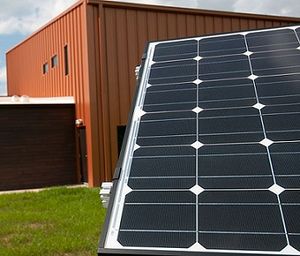Types of PV cells

Photovoltaic cells or PV cells can be manufactured from a variety of different materials. Despite this difference, they all perform the same task of harvesting solar energy and converting it to useful electricity. The most common material for solar panel construction is crystalline silicon which has semiconducting properties.[2] Hundreds of these solar cells are required to make up a full photovoltaic array.
There are four main types of solar panels that are commercially available, and they include monocrystalline silicon PV, polycrystalline silicon PV, amorphous silicon PV, and hybrid PV.[3] Currently, the first two cells are the most common and make up 93% of all solar panels sold worldwide. Amorphous silicon accounts for 4.2% of global solar panel sales.[3]
Monocrystalline Silicon Cell
These cells are composed primarily of silicon crystals. To produce these, a cylindrical crystal of silicon is "grown" from molten silicon. This crystal is then cut into thin slices and shaped into a hexagon so that they fit together well on the solar panel. These cells are smooth in appearance and are rigid, thus they must be mounted in a sturdy frame to prevent them from breaking.[4] Generally speaking, these cells have efficiencies of 13-16% and are the most efficient of the silicon-type cells.[3] Additionally, these panels yield more power per unit area and are thus more space efficient. As well, these panels live longer than polycrystalline varieties and perform better in low light conditions.[5] However, they are more expensive and time consuming to produce than the polycrystalline variety. These cells also do not perform as well in cold conditions.[5]

Polycrystalline Silicon Cell
These cells are also composed primarily of silicon, but instead high purity molten silicon is shaped using a cast and cooled under controlled conditions in a mould. It sets somewhat irregularly into multi-crystal form, giving the final product a speckled appearance, shown in Figure 2.[4] This square block is then cut into thin slices and the slices are arranged on the panel. The cell is then coated with an anti-reflective coating (which gives the cell its blue colour) to ensure maximum absorption of light. These cells generally have efficiencies of 12-16%, and are less expensive than monocrystalline varieties.[3]
Amorphous Silicon Cell

This type of cell is made from non-crystalline or amorphous silicon and is one type of thin film cell. The film of amorphous silicon is sprayed as a gas onto some surface, such as glass or flexible rubber material. After this a conducting grid and electrical contacts are attached. This cell is especially thin so less raw material is needed as compared to crystalline silicon cells. These are fairly inefficient cells, only about 6-8% efficient, and are thus not suitable for use on residential developments as they require large amounts of space.[5] However they are still used in a number of solar devices.[3] This type of cell is generally found in solar powered calculators or other small solar devices. One property of these cells is that their power output is reduced over time, especially in the first few months of use. However after these few months the output does tend to stabilize.[4]
Hybrid Cell
These types of cells are simply PV cells that use two different types of PV technology. For example, a hybrid cell could be composed of a monocrystalline PV cell covered by a layer of amorphous silicon. These cells generally perform well at high temperatures and have efficiencies exceeding 18%.[3] However, these cells can be very expensive.
Other Types of Cells
The four types of cells listed above are the most commonly used solar cells, however there are many other types of cells that exist but are not used widely. There are many other kinds of thin film cells that are built using some material other than silicon. These cells include cadmium telluride (9-11% efficient), copper indium gallium selenide (sometimes known as CIGS, they are 10-12% efficient), and organic photovoltaic cells.[5] However, the only cell that is as cost-efficient as silicon panels is currently the cadmium telluride cell. CIGS cells show the most promise in terms of efficiency in the future, and contain smaller amounts of toxic cadmium than other alternatives.[5] Organic photovoltaics are simply photovoltaic cells that utilize inexpensive plastics and electronics that are made of conductive organic molecules. They are not widely used. For more on organic photovoltaics, click here.
Concentrating photovoltaics are also an option, but are not widely used. These photovoltaics simply use some sort of solar collector - generally composed of lenses or mirrors - to concentrate sunlight on a smaller number of photovoltaic cells. This decreases the number of overall cells needed - thus decreasing the overall cost of the setup - while still maintaining a significant energy output from the panel. This type of cell setup could be more efficient, but methods to deal with he increased temperatures would have to be developed.[8]
References
- ↑ "20110504-RD-LSC-0621 - Flickr - USDAgov" by U.S. Department of Agriculture. Licensed under CC BY 2.0 via Wikimedia Commons - http://commons.wikimedia.org/wiki/File:20110504-RD-LSC-0621_-_Flickr_-_USDAgov.jpg#/media/File:20110504-RD-LSC-0621_-_Flickr_-_USDAgov.jpg
- ↑ Alternative Energy. (August 18, 2015). Common Types of Solar Cells [Online]. Available: http://www.altenergy.org/renewables/solar/common-types-of-solar-cells.html
- ↑ 3.0 3.1 3.2 3.3 3.4 3.5 SunStation. (August 18, 2015). Types of Solar Cells [Online]. Available: http://sunstationscotland.net/TypesOfPVcell.html
- ↑ 4.0 4.1 4.2 Solar-Facts. (August 18, 2015). Types of Solar Cells [Online]. Available: http://www.solar-facts.com/panels/panel-types.php
- ↑ 5.0 5.1 5.2 5.3 5.4 Energy Informative. (August 18, 2015). Which Solar Cell is Best for You? [Online]. Available: http://energyinformative.org/best-solar-panel-monocrystalline-polycrystalline-thin-film/#crystalline-silicon
- ↑ Wikimedia Commons. (August 18, 2015). Comparison of Solar Cells [Online]. Available: https://upload.wikimedia.org/wikipedia/commons/7/71/Comparison_solar_cell_poly-Si_vs_mono-Si.png
- ↑ Wikimedia Commons. (August 18, 2015). Thin Film Flexible Solar Panel [Online]. Available: https://upload.wikimedia.org/wikipedia/commons/d/d8/Thin_Film_Flexible_Solar_PV_Installation_2.JPG
- ↑ Solar-Facts. (August 18, 2015). Concentrating Solar Power [Online]. Available: http://www.solar-facts.com/panels/concentrating-photovoltaic.php

